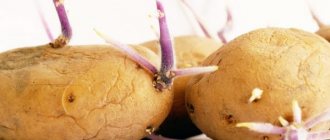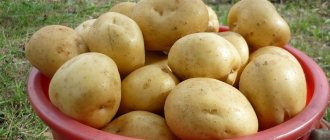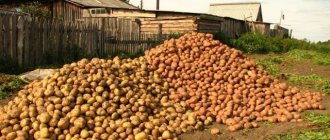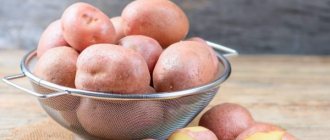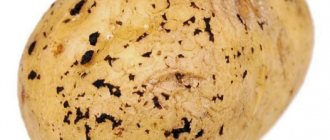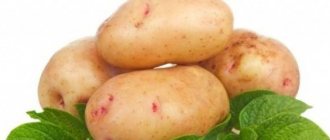How to care
Caring for Aladdin will not cause much trouble if you follow simple rules.
Watering
There is no need to water the potato bushes; watering is needed only if the weather is dry. In this case, watering is carried out exclusively in furrows; with direct watering, there is a high risk of the potato becoming infected with fungal diseases.
If the summer is hot, you should never water during the day, otherwise you can harm the tubers. The most suitable time for watering is morning.
Feeding
To achieve maximum yield from Aladdin, you need to periodically feed the plants. During the growing season, root feeding is applied three times:
- The first is done during the growth of the tops, if the bushes have poor development, the stems are too thin, and the leaves have a pale appearance. To prepare the fertilizer, you need to dilute 1 tbsp. l. urea 10 liters of water. Apply 0.5 liters of solution per bush.
- The second is applied during the period of bud formation to speed up flowering. 1 tbsp. l. potassium sulfate and 3 tbsp. l. wood ash is diluted with 10 liters of water. 0.5 liters of solution is poured under each bush.
- The third is produced when the potatoes are flowering to promote the process of tuber formation. 2 tbsp. l. superphosphate and 1 glass of mullein are diluted with 10 liters of water. Apply 0.5 liters of solution per bush.
Find out more about fertilizing potatoes.
Weeding and loosening the soil
From time to time it is necessary to do weeding, both separately and in combination with loosening, which will help get rid of small weeds.
Care is needed for loosening, otherwise the sprouts and tubers can be damaged; the depth in the soil should be 2-3 centimeters. This procedure has a good effect on potatoes, since when loosened, the root system is better enriched with oxygen
Did you know? The Indians were the first to grow potatoes in what is now Peru.
It is necessary to loosen the soil for the first time a week after planting. Then this procedure is carried out as necessary after rain and watering to prevent the formation of a crust on the ground.
Hilling
Hilling promotes a good harvest, accelerating the process of bush development, flowering and tuber formation. To hill up a bush, you need to use a hoe to rake a small amount of wet soil to the tops so that there is a mound around the bush.
Potatoes need to be hilled three times during the season. The first hilling of the bushes is carried out when they reach a height of 10–12 centimeters. The second hilling should be carried out 10–12 days after the first. The third hilling is carried out as needed.
Preventative treatment
To protect “Aladdin” from late blight and alternaria, for preventive purposes it is necessary to spray with special preparations. The first spraying must be done before the plant shows signs of disease, when the bushes grow to 20 centimeters. The next treatment is carried out after 7 days if the weather during this time was dry and after 4 days if there was precipitation.
To protect potatoes from the Colorado potato beetle, spraying with special preparations is done when the first larvae appear on the bushes. Since the larvae hatch in three generations, spraying is done three times with a frequency of 10 days.
Read also about the fight against the Colorado potato beetle using folk methods (mustard and vinegar) and with the help of drugs: “Prestige”, “Tabu”, “Regent”, “Confidor”, “Tanrek”, “Napoval”, “Commander”, “Molniya” "
Care after landing
Following simple agrotechnical rules will help you obtain a harvest of excellent quality.
Fertilizer
For the Aladdin potato variety, organic and mineral fertilizers are suitable, which should be applied alternately. The first fertilizing after planting is carried out after the sprouts appear, immediately before the first hilling. At this stage, add a combination of 1 tsp. urea and 1.5 tbsp. humus. This amount is enough to enrich 1 m² of planting area with nutrients. If the soil is too dry, it is better to use a urea solution - add 1 tbsp to 10 liters of water. l. substances. 0.5 liters of working solution is poured under each plant.
At the time the buds appear, potassium-containing compounds will be required. The ideal organic fertilizer in this regard is wood ash. Add 300–400 g of ash to 10 liters of water. The solution is applied under the root and along the leaf by spraying.
The third time fertilizer is applied during potato flowering. For 10 liters of water add 2 tbsp. l. superphosphate and 1 tbsp. mullein The resulting composition is distributed into 0.5 liters per plant, poured under the root.
Watering
Additional moisture is required only if there is insufficient precipitation. Water is applied directly into the rows from a hose. The main thing is that the liquid does not get on the green part of the plants, otherwise there is a high risk of developing stem rot. The most suitable time for watering is evening. In summer, when the heat is intense, watering should be done once a week.
Weeding and hilling
The Aladdin potato variety will bear fruit poorly if you do not weed the weeds in time. A mandatory measure is to loosen the soil between the rows to a depth of 10 cm every 10 days.
The first hilling is carried out when the plants reach a height of 14 cm. The procedure involves the formation of a mound of soil taken from the rows around the plant stem. The second hilling is carried out 3 weeks after the first. This manipulation allows not only to protect plants from return frosts, but also stimulates the development of additional roots, which helps strengthen the plant and increase its resistance.
Characteristics and description
general characteristics
Vegetables "Aladdin" are medium-late ripening table varieties. Potatoes can be harvested from the beds 90–100 days after planting. In cold climates, quality tubers are obtained in 110 days. It is recommended to grow through germination. The variety is successfully cultivated in both southern and northern regions.
Description of appearance and photo
Escapes
The height of potato bushes is 50 cm. The crops are distinguished by elongated foliage with an emerald tint. The corollas of the variety are small or medium in size. The root system is well developed.
Roots
The small tubers have a rounded shape. The peel is red-pink, very smooth, with faintly pronounced eyes. From 8 to 12 pieces are collected from one bush. vegetables The juicy pulp has a white tint when cut.
Below you will see what this variety looks like:
Seeding rate and yield per 1 ha
The potato variety "Aladdin" is characterized as quite productive. With proper agricultural technology, up to 45 tons of vegetables can be harvested from 1 hectare of planting area.
When planting, it is recommended to divide potatoes into small fractions (weight no more than 35–50 g). When the distances between holes are 32–36 cm per 1 hectare, 40 thousand pieces are used. A garden acre requires 400 tubers.
Taste
Aladdin potatoes are distinguished by high taste qualities; experts rated them 4.9 points out of 5 possible. The pulp of the vegetables is crumbly, the consistency is pleasant, not dry and not watery.
Chemical composition
Aladdin variety is low-calorie. The tubers contain a high potassium content; regular consumption of such potatoes helps eliminate swelling by removing excess water and salts from the body. Baked and boiled vegetables have a good effect on the gastrointestinal tract and restore acidity levels. The amount of starch is about 20%.
Average tuber weight
Aladdin potatoes are quite large. The weight of one vegetable ranges from 100 to 110 g. Under favorable conditions, some tubers reach 180 g.
Marketability
Externally, the potatoes are very presentable. Marketability is the ratio of the amount of crop sold to the total number of potatoes grown. In each case the indicator is individual. On average, marketability is 95%.
Resistance to diseases and pests
The variety is highly resistant to diseases:
- late blight;
- potato cancer;
- common scab.
Potatoes "Aladdin" are not affected by pests such as:
- nematode;
- potato flea beetles.
Keeping quality
The shelf life index is very high, it is approximately 95%. In cool storage, potato tubers can be stored efficiently for up to six months.
Where is it used?
The variety is best used for boiling, stewing, baking, and making chips. Potatoes are not recommended for frying. The vegetable is not so good in fresh salads. But in first courses it doesn’t boil over.
The variety is cultivated everywhere. Potatoes are resistant to both cold and drought. A good harvest is harvested both in the south and in the northern regions.
Characteristic
Aladdin potatoes quickly gained wide popularity in almost all regions of the country and beyond. It is an unpretentious variety. Excellent for cultivation on loamy and sandy soil.
It is excellently grown by gardeners on private plots. It is also popular among owners of small potato farms. It can grow both in the south and in the north of the country.
Experienced gardeners recommend pre-germination. This method especially applies to cold regions. Seedlings should be prepared 30-35 days before planting. Sorting this subspecies of potatoes into fractions is mandatory. The tubers must be divided into small fractions of 35-55 grams.
It is recommended to plant the variety at a distance of 32-36 cm between plants. About 40,000 tubers can be planted on 1 hectare. The stolons of the plant are moderate. Because of this, it is recommended to plant tubers deeper than other potato subspecies.
The planting depth should be at least 10 cm. Plantings should be located from north to south. The variety is insensitive to growth regulators. Metribuzin is well tolerated.
See below: potato variety Aladdin photo
How to properly care for the variety
After planting, mass shoots appear in the third week. Further supervision of them does not go beyond the usual activities for farmers.
Watering and fertilizing
Aladin potatoes are not demanding of moisture. Water it only in hot summers without rain. Water is supplied with a hose into the row spacing. Irrigate in the morning or at sunset. At the same time, the plants are fed.
First, the plant is fed with urea and humus. Then potassium compounds. Ash is added between the rows. In the last feeding, superphosphate and mullein are diluted. The feeding rate is 0.5 liters per plant.
Weeding and hilling
These procedures have two purposes: they help get rid of weeds and deliver oxygen to the roots.
Weed the vegetable immediately after mass germination. In the row spacing, the soil is loosened to a depth of 7-10 cm, in a row - 3 cm. When the tops have grown by 14-15 cm, the bushes are hilled up - the soil from the row spacing is raked under them. Hill up a second time after 3 weeks.
Potato harvest
Harvesting and storage
3 weeks before ripening, the tops are mowed. Harvesting occurs in mid-August or September. Dig up the tubers with a pitchfork, shovel or cultivator. Then they are left in the light for several hours - this way the tubers dry out and are disinfected from fungi.
Then they sort and reject diseased specimens. Potatoes for storage are laid out in boxes and lowered into the cellar. Storage temperature +2-8 °C. The room is ventilated, dried, treated with preparations against fungi and rot.
Important! Under normal conditions, potatoes remain 92-94% fresh.
Description of the potato variety Melody
In the Black Earth Region, Melodiya pleases with its harvest and taste. Maybe the variety is good in other regions, but so far this comment is only from one.
Melody grows as a powerful bush; wide row spacing is required - 80 cm. It blooms with red-violet corollas. In terms of ripening time, this is a medium-late variety - 100-120 days.
Potato Melody
Tubers in nests are located compactly. They are oval with a yellow, mesh-like skin, and the eyes are superficial. The pulp is also yellow, boils well, and is very tasty. The variety is resistant to nematodes, moderately resistant to late blight. The harvest ripens in the fall, at the height of this disease, so it is better to do prevention.
Red Scarlet Potatoes
Many gardeners speak well of it. The variety is consistently productive and never fails. This Dutchman is considered one of the best among the Redskins. Ripening time is 75 days, keeping quality is excellent.
Red Scarlet in Altai
The tubers are oval, bright red. The pulp is yellow, slightly boiled. The variety can be affected by scab and late blight on the tops, but the tubers are resistant to this disease. Fruitful, tasty, beautiful. Widely distributed in the Central and Southern regions. But, judging by the reviews, both Belarus and Siberia are happy with it.
Cross-section of Red Scarlet potatoes
Common features of Dutch varieties: high yield, beautiful tubers that are uniform in shape and size, resistance to nematodes and viral diseases such as potato cancer.
You can discuss the topic
The main advantages and disadvantages of the variety
Summer residents and rural residents plant different varieties of potatoes, evaluate the quality, and choose the best for their plot. Before purchasing seeds of the Aladdin variety, take a closer look at its advantages and disadvantages.
The advantages are as follows:
- late ripening and, as a result, storage until May;
- high yield - half a ton per hectare;
- taste characteristics and nutritional value;
- resistance to typical potato diseases;
- transportability without significant losses;
- attractive presentation.
The advantages of the variety persuade farmers to grow the root crop.
For your information! The disadvantage of the variety is that it does not respond to nitrogenous fertilizers. This kind of feeding is unnecessary for him.
Potato variety Aladdin
Aladdin is a mid-late table potato variety (Solanum tuberosum) of Dutch selection. Developed by Agrico specialists. It can grow in any climatic conditions on various types of soils, it is plastic. Valued for its high yield, resistance to late blight and drought. Suitable for mechanical cleaning. It is characterized by very large tuber sizes.
The period from the appearance of full shoots to harvest takes 90−110 days.
Plants are of medium height, no more than half a meter. The leaves are elongated, green with an emerald tint. Corolla small or medium.
The root system is well developed, in one nest 8-12 large round-oval tubers are formed, with an average weight of 100-180 grams. The peel is red, smooth to the touch. The pulp is white when cut. The eyes are small and shallow.
Aladdin's productivity is high - 450−500 c/ha. According to the observations of gardeners, an average of about 2.5 kg of potatoes can be reliably harvested from one plant. Keeping quality of tubers is 94%.
The taste is excellent; experts rate them 4.9 points out of 5. The starch content is quite high - 21%, making the variety excellent for processing into chips. According to gardeners, its puree is the most delicious! The tubers boil well, do not darken during heat treatment, the pulp is crumbly, has a pleasant consistency, not dry or watery. Tuber vegetables are best suited for boiling, baking, and work well as fillings. They are not particularly suitable for frying and preparing salads - if you overlook them a little, you will end up with mashed potatoes in a frying pan instead of fried potatoes.
Aladdin is not picky about soil and climate, but grows better on loose fertile soils - sandy loam and light loam. The plants are unpretentious in care, but there are several growing features.
- Experts recommend germinating tubers before planting. This will improve germination and shorten the growing season.
- Be careful when planting sprouted tubers - breaking off the sprouts will have a very negative impact on the amount of yield per plant and in general.
- It is recommended to plant the seed material of the variety a little deeper than usual. About 10−12 cm on light soils and 6−8 cm on heavy soils. The tubers are planted at a distance of about 32 cm from each other.
- The originator advises planting 40 thousand plants per hectare of area, or 400 plants per hundred square meters.
- As mentioned at the beginning, potatoes are drought-resistant, but you should not completely forget about watering. Also, do not neglect fertilizing, weeding, loosening, hilling, and preventive treatments against pests and diseases.
- Be careful with nitrogen fertilizers! Their excessive quantity can lead to increased growth rates of tops to the detriment of tuber formation.
The variety has very high resistance to late blight, as well as common scab, cancer, golden cyst nematode, and rot.
Aladdin managed to win many positive reviews from gardeners. It is especially valued for its excellent taste, high yield, drought resistance, excellent shelf life and transportability, excellent presentation, resistance to the most common diseases, and most importantly to late blight. As you can understand, this potato has quite a lot of advantages, but no disadvantages have been found yet. With proper care, it will clearly delight you with a tasty and large harvest!
About cultivation technology
The named potato variety grows well on any soil - sandy, loamy, black soil. When planning, you need to arrange the rows from north to south. The planting method depends on the area of the site. It is clear that you cannot plant a large garden with a shovel. The average depth for planting is 10-15 cm. The distance from the center of one hole to another is 30-35 cm. It is estimated that with this approach, the consumption of seed material will be 40 thousand tubers per hectare. Many gardeners believe that further growing potatoes will not be difficult, however, it is better to use the tips below:
- Immediately after the land is harrowed, you should not water the potato field: the abundance of moisture prevents the development of the root system. It is necessary to irrigate after seedlings have appeared and the soil is very dry.
- After watering, you should not allow the top layer of soil to become crusty: the roots stop breathing. Loosening and hilling are necessary. At the same time, the hardworking person removes weeds.
- Between waterings, it is necessary to scatter fertilizers around the area, alternating organic and mineral.
- It should be remembered that you should not plant potatoes in the same area every year: the soil, giving the same nutrients, replenishes them, so the yield of the cultivated crop will decrease. Cereals planted after potatoes restore the balance of the soil, but it will take two to three years before the field can be used for potatoes again.
A little about the universal varieties Aladdin - type B potatoes, which are considered universal, which is expressed in the following qualities:
- dense pulp;
- moderate wateriness.
Potatoes of universal varieties can be fried, stewed, boiled. Type “B” includes the following varieties: Rumba, Carrera, Scarlet, Sante. All of them are high yielding.
- Sante differs from Aladdin in the yellow color of the peel and light yellow flesh. It is resistant to diseases of nightshade plants, therefore it is grown without chemical treatment of fields.
- Rumba adapts well to any climatic conditions, is resistant to diseases, and does not degenerate. Due to its low sugar content, it is recommended for diabetics. The following two species are characterized by early ripening:
- Scarlet ripens in two months, and the weight of the tubers will reach 100-120 g. It easily tolerates drought. well kept. The red tubers with yellow flesh are very tasty.
- Carrera is considered an extremely early variety, so you can harvest two harvests of this variety in one season. The tubers are oval in shape, with small eyes that are distributed symmetrically. The peel is very smooth, yellow in color. The pulp is creamy and does not change color when cooked. The variety is resistant to late blight, scab, and rotting.
General characteristics of the variety
According to the description, Aladdin potatoes can grow on any soil, in regions with both cold and warm climates. It is thanks to its excellent characteristics that the variety is cultivated almost everywhere.
Origin story
The Aladdin potato variety, known for its productivity, was bred in Holland by specialists from the agricultural company Agrico. It was entered into the Russian state register in 2011.
The distinctive features of the resulting variety are:
- medium spreading of bushes;
- plant height up to 50 cm;
- powerful erect stems of a purple hue;
- elongated leaf plates;
- small size flowers.
Chemical composition and trace elements
Potato pulp has a high starch content - almost 22%. This indicator directly depends on the type of soil and the time of planting. Tubers contain manganese, fluorine, boron, cobalt and calcium.
Ripening period
The ripening time of tubers, according to the description of the variety, varies from 90 to 110 days from the moment the planting material is planted in the soil. It all depends on the climate in a particular region; the warmer it is, the faster the potatoes ripen in the garden.
Productivity
According to reviews, the mid-late potato variety Aladdin shows high productivity, both in private plots and when grown on large farms. The bushes actively grow and develop on sandy soil, alumina and floodplain soil.
On average, one plant contains 12 tubers, each weighing 100-180 grams. From 1 sq.m., when planting the variety in arid areas, it is possible to harvest about 3 kg of potatoes from one bush, and in conditions of sufficient humidity - up to 4 kg.
Disease resistance
The Aladdin potato variety is highly resistant to the most dangerous nightshade diseases:
- late blight;
- common scab;
- potato cancer;
- golden nematode.
Diseases such as:
- Dry spotting. This dangerous disease of fungal origin spreads with drops of water during rain and during irrigation activities. High humidity contributes to the progression of the disease.
- Alternaria blight. The disease attacks potato plantings in dry, hot weather, and young shoots are especially affected. The cause of the disease is insufficient mineralization of the soil. Its signs are brown spots on the leaves.
Dangerous potato pests include wireworm, Colorado potato beetle, mole cricket, and potato moth.
Growing regions
According to reviews, you can plant Aladdin potatoes everywhere. The variety is distinguished by both drought resistance and resistance to adverse environmental factors. This mid-late species is cultivated in both the south and northern regions.
Diseases and pests
"Aladdin" is highly resistant to diseases:
- Late blight;
- Common scab;
- Golden nematode;
- Malignant tumors.
This variety of potato is most often affected by the following diseases:
- Dry spotting. Diseased bushes are treated with the following preparations: “Baktofit”, “Planriz”;
- Colorado beetle. On an area of up to 10 acres, the larvae are collected by hand; on large plantations, the bushes are sprayed with insecticides: Arrivo, Microtsin.
Description of the potato variety Aladdin
Aladdin is a potato variety bred by Dutch breeders (Agrico company, Emmeloord). It has begun to spread in Russia and neighboring countries in the last 5–7 years. Recommended for cultivation in the North-West region, as well as in the Moscow region and the middle zone.
The variety is unpretentious, so it can be grown in other regions of the country. Prefers loose, light soils – loams. There are no special requirements for growing conditions - it can easily tolerate both long-term droughts and cloudy weather.
Main characteristics of the variety:
- medium-late (ripening period 90–110 days from the moment of emergence);
- medium-sized bush (up to 50–75 cm), spreading;
- starch content: 18–21%.
Aladdin potato shoots are erect and strong. The leaves are elongated, rich emerald green in color. The corolla is small in size.
Each plant produces 8–12 (rarely 15) large tubers, the weight of which reaches 100–180 g. Individual specimens weigh 500–800 g. The shape is round-oval, diameter 5–6 cm. The peel is red, the surface is smooth, the eyes are hardly noticeable. The pulp is white, with creamy shades.
Aladdin potato tubers are valued for their good taste and boiliness
Agricultural technology
The variety has a high yield. Up to 450 centners of fruits are harvested from 1 hectare. One bush produces 10 tubers. Agricultural technology is not something special. To get a high-quality harvest, you should add a small amount of nitrogen.
This subspecies of potato responds well to the application of mineral and organic fertilizers. These types of fertilizing must be alternated. Read more about how to feed potatoes, when and how to apply fertilizers, and how to do it correctly when planting.
The variety requires constant removal of weeds. After the procedure, it is necessary to hill up the potato tops: this can be done either manually or using a walk-behind tractor.
The drought resistance of the variety is moderate. Watering must be carried out between rows. Potatoes should be watered when the soil is very dry. After watering, it is recommended to slightly loosen the soil. This procedure promotes the penetration of oxygen to the roots of the plant. Mulching the row spacing won't hurt either.
The bushes reach a height of 0.5 m. The leaves are elongated and emerald green. The corolla is small or medium in size.
Important! It is strictly forbidden to break off shoots more than once. This procedure inherently affects the number of tubers
Otherwise, tuberization will be poor. Instead of the standard 10, the plant can form less than 5 tubers.
There are a large number of ways to grow potatoes. We have collected a lot of interesting information on this topic for you. Read all about growing potatoes under straw, in bags, in barrels, in boxes, from seeds.
And also about modern Dutch technologies, about growing early varieties, about how to get a good harvest without weeding and hilling.
Planting and caring for Uladar potatoes
The Uladar variety is not particularly demanding in care, which is why it is loved by many owners of large agricultural farms. However, knowing the nuances of its agricultural technology, you can significantly increase productivity.
Selection and preparation of a landing site
Potatoes of the Uladar variety can be successfully grown on any soil, however, they will reveal their full potential on light and medium soil in terms of particle size distribution. It is best if it is sandy loam soil, black soil and peat. It is not recommended to plant potatoes in lowlands and places where water stagnates.
In autumn, the area under the potato field is dug up, the layer is turned to a depth of 25-28 cm, and organic fertilizers are applied. In the spring, compost or manure is added to the soil; if this was not done in the fall, the soil is loosened to a depth of 12-15 cm, enriching it with oxygen. Immediately before planting, the area is dug up using a shovel and leveled with a rake.
Attention! The best predecessors of potatoes are considered to be grain crops, forage grasses, flax, lupine, and legumes.
Preparation of planting material
A month before planting, seed potatoes are sorted, rejecting tubers with mechanical damage, rot and similar defects. Selected root crops are placed in boxes in 2-3 layers for vernalization. The container with potatoes is placed in a warm and well-lit place with a temperature of 14-15°C. Soon light shoots will begin to appear on the tubers.
Immediately before planting in the ground, you can treat seed potatoes with insecticides against the Colorado potato beetle (Prestige, Commander), as well as growth stimulants.
Landing rules
Early Uladar potatoes begin to be planted in May, when the soil temperature is more than 7-10 ° C at a depth of 10 cm. Tubers are placed in holes 8-10 cm with sprouts up, in the case of heavy clay soils - 6-7 cm. Distance between rows – 60 cm, between neighboring bushes – 35 cm.
Watering and fertilizing
Uladar tolerates short-term drought, but if it is prolonged, it needs watering. Moist soil is especially important in the period before flowering, when tubers are being laid. Uladara plantings must be watered to a depth of at least 20-30 cm so that the moisture reaches the deepest roots. One watering every 2-2.5 weeks throughout the growing season is enough.
Uladar potatoes are characterized by increased tuberization in the first half of the growing season. Regular application of mineral fertilizers at this time will help the potato bush to form a larger number of tubers and qualitatively increase their mass.
Attention! Potatoes are watered in furrows so as not to wash away the soil around the tubers.
Loosening and weeding
After planting, Uladar potatoes especially need oxygen. Knowing this feature, you need to carefully plow the soil between the rows as soon as the first shoots appear. During the season, you should regularly weed the plantings and loosen the soil.
Hilling
The first time the potatoes are hilled up when the height of the bush is 5-8 cm. Wet soil is raked from the rows to the bushes, first on one side and then on the opposite side. It is not recommended to hill up in the heat or in the sun, since warm, poured soil negatively affects the stems and their development. It is best to hill up after rain, early in the morning or late in the evening.
The second time hilling is carried out when the potatoes reach a height of 15-20 cm, before flowering. The height of the hill should be at least 15-18 cm. The third hilling is carried out when the plant height is 25-30 cm, the height of the embankment is 17-20 cm.
Comment! Without hilling, Uladar's yield will decrease by 20-25%.
Features of planting, growing and care
Aladdin can grow on any soil - floodplain soil, black soil, loamy and sandy loam soil. But the main condition is that the site must be open and sunny. Peculiarities:
- Shrubs should be planted on the north and northeast sides for protection, and the slope should be on the south and southwest.
- It is not advisable to water the tubers immediately after planting.
- Potatoes do not like abundant water, so they are not planted in a low place with clay soil, as stagnation of liquid forms here in the spring.
- For the same reason, groundwater should not be allowed to be at a distance of a meter from the surface where Aladdin is planted.
- It is prohibited to select the same areas for this potato every year. Otherwise, the soil will be filled with a large number of pests, after which it will begin to become sick and depleted. Therefore, it is possible to return Aladdin to his original place only after at least 3 years.
- To increase productivity, potatoes should be planted after beans, cucumbers, grains, pumpkin crops, and cabbage have been grown on the field.
- It is forbidden to plant Aladdin after tomatoes, nightshade and sunflower plants have grown on the site.
- Bookmark depth – from 10 to 12 cm.
- For 1 hectare you will need 35-40 tubers.
- The shoots break off only once, since frequent breaking off leads to improper formation of the potato.
- The distance between fractions should be from 32 to 36 cm.
Planting dates and regions
As mentioned above, in the southern regions potatoes ripen in 90 days, and they must be harvested in September. Accordingly, the landing is planned for mid-June.
In areas on the northern side of the country, Aladdin should be planted in May. The soil temperature must be taken into account - 7-8 degrees. The air temperature should not be lower than 8.
For Aladdin, regionality does not matter, because the variety is not afraid of drought. North, west, south and east are equally great.
Preparation of soil and planting material
Before planting, tubers must be germinated, especially in the northern regions. This should be done about a month before the date of planting the material. To do this, the tubers are placed in a room with a temperature of +7 degrees.
This approach makes it possible to find out which potatoes will germinate in the future. If there are tubers with buds that have not sprouted, they should not be planted. Each root vegetable is cut into fractions weighing up to 50 grams.
The soil, as when planting any crop, should be moistened, but it is prohibited to fill it with copious amounts of water. Otherwise, the potatoes will take too long to germinate.
Hilling
Hilling up potatoes accelerates the process of growth and development of tops, promotes the formation of new tubers, and improves flowering. To do this, use a hoe to rake a little soil towards the bush. But before doing this, it is important to slightly moisten the soil. Thus, a mound is obtained.
Hilling is carried out three times:
- for the first time, the height of the bush should be 11-12 cm;
- the second hilling is carried out 10 days after the first time;
- a third time - as necessary.
Weeding and loosening
You need to constantly weed your garden to remove weeds, as they absorb nutrients from the soil and prevent the tubers from developing normally.
It is important to periodically loosen the potatoes, but do it carefully. You can deepen the garden tool no more than 3 cm. Otherwise, the tubers and sprouts will be damaged.
Loosening is carried out 7-8 days after planting, and then after each moistening (rain, watering). This makes it possible to prevent the formation of a dry crust and get rid of the weed.
Watering and fertilizing
Watering Aladdin is often not recommended - only in very dry weather. There are also watering features:
- It is prohibited to pour water under the bush, only into the side grooves (this will eliminate the risk of diseases);
- Watering is carried out mainly in the morning, since the scorching sun is harmful.
Fertilizing is carried out to increase productivity three times during the growing season. This is done this way:
- The first time a solution of urea is introduced (1 tablespoon per 10 liters of water) during the growth period of the bush. It is especially important when the tops develop poorly, have weakened stems, and the leaves look pale. Half a liter of solution is needed per bush.
- The second feeding is needed when the buds are forming. This will speed up the flowering process. Use a solution of potassium sulfate (1 tbsp), wood ash (3 tbsp) and water (10 liters). 0.5 liters of the mixture is poured under each plant.
- The third time the soil is fertilized during active flowering. For 10 liters of water you need 200 ml of mullein, 2 tablespoons of superphosphate. Watering is carried out in the same way as in previous cases.
Diseases and pests
Aladdin is not susceptible to late blight, but may have alternaria blight. It affects shoots and leaf parts. Occurs in 25 cases out of 100. A distinctive feature is brown spots at first, yellow later. After drying, the leaves fall off. If you dig up the tubers, you will notice indentation-type spots on them. This leads to deformation of the tubers.
Among the pests that attack Aladdin are the Colorado potato beetle, mole cricket, wireworm, and potato moth.
Preventative treatment
In order to prevent potato diseases and insect attacks, preventive measures are taken:
- To protect against Alternaria blight, plants are sprayed using specialized preparations. The first time - the bush should not exceed 20 cm, and there should be no signs of disease. The second time - after a week. If it rains after spraying, repeat spraying after 3-4 days. Products: Abiga-Pik, Profit, Acrobat MC, Polyram.
- For the Colorado potato beetle, spraying is carried out with such preparations as Tanrek, Confidor, Commander, Napoval, Prestige, Regent, Molniya, Tabu. You can use a mixture of vinegar and mustard. The beetle larvae hatch in 3 stages, so you need to spray the bushes three times. The first time - when they appear on the leaves, the remaining 2 times - every 10 days.
- You can destroy the mole cricket with the help of Boverin and Nemabakt. These are biological agents that infect the larvae with bacteria that destroy mole crickets. Among the drugs you can use Maxim, Prestige. Tubers are treated with these solutions before planting. There are also folk remedies. You can boil the porridge, add Regent to it and make small balls that are thrown into the holes. The mole cricket is afraid of the smell of fish, marigolds, beer, and pine.
- To get rid of wireworms, the following drugs are suitable: Zemlin, Provotox, Pochin, Barguzin, Medvetox.
- Potato moth does not tolerate Dendrobacillin, Lepidotsid, Enterobacterin, Bitoxibacillin, etc.
Description of the variety
Aladdin “registered” in the state register of Russia in 2011. This is a representative of late-ripening table varieties, the tubers of which are ready for consumption 90-100 days from the moment they are planted in the ground. In colder regions, the ripening period lasts even longer - up to 110 days.
Aladdin has excellent protective characteristics. It is resistant to late blight, rarely suffers from such a serious illness as potato cancer, and scab is also not scary for it. It grows well on loam and sandy soils and can withstand dry periods, so it can be safely grown in the south of our country.
The plant bushes are erect, about half a meter high. The stems are fleshy, strong, and have a purple tint. The leaves are slightly elongated, mostly dark with a barely noticeable emerald tint. The flowers are collected in a corolla and are small in size.
The yield deserves special praise; in many regions its indicators reach 450 c/ha. Each bush produces up to 12 potatoes, the weight of which varies from 100 to 180 g.
Correct fit
To prevent potatoes from degenerating, you need to maintain a crop rotation according to a 3x3 scheme: potatoes grow in a given area for three years, depleting the soil, then the area is sown with grain crops for three years, restoring the balance of nutrients, then you can plant potatoes again.
Planting potatoes Method of planting potatoes to obtain a high yield From A to Z:
Site selection
Main criteria for choosing a site:
- Illumination. There should be no trees or buildings around potato beds to ensure maximum daylight hours. An important factor is orientation to the cardinal points - the beds need to be laid out in the north-south direction;
- Ventilation. The area should be well ventilated - this is a preventive measure against fungal diseases. On the north side, bushes or a low fence are allowed to protect from cold air currents.
Soil preparation
In October-November, the future garden is plowed with the addition of organic fertilizers (preference is given to manure or humus). The same procedure can be carried out in early spring after the snow has melted, but in this case the manure must be well rotted, or diluted droppings can be added.
Seed preparation
Pre-planting preparation of tubers takes place in several stages:
- Sorting. Large, whole tubers are selected for planting, without signs of spoilage or rotting, and uniform in color;
- Germination. On the 20th of April, the seeds are taken out into a well-lit room with a temperature of up to 10*C. Root crops that do not sprout within 2 weeks are discarded.
Planting Density
The beds are marked in the traditional way:
- The interval between bushes is 35 cm;
- Row spacing – 75 cm;
- Planting depth – 10cm.
Boarding time
The optimal planting period in mid-latitudes is mid-May. At this time, the soil is already warmed up to 10*C, the length of a sunny day exceeds 12 hours. In addition, when planting in May, the harvest date shifts to early to mid-September, when the weather remains dry (“Indian summer”).
Like any potato, “Aladdin” needs timely release from weed competition and a sufficient amount of moisture in the soil.
Large potato harvest:
Watering
You can water the beds using either a drip system or traditional methods.
It is important to follow the following rules:
- During periods of drought (air temperature above 27*C), water the garden every 5 days, at other times - every 10 days.
- Never water the beds in the morning or afternoon, but only after sunset.
- Avoid getting water on the green parts of plants to avoid the development of fungus.
- The first time potatoes are watered only after emergence.
Loosening
In cool weather, the soil is loosened regularly - this is necessary for oxygen exchange. During drought, shallow loosening is carried out only to break the earthen crust.
Feeding
For “Aladdin”, the ideal system is 4 feedings:
- When landing. Ash, peat, and eggshells are added to the holes or furrows;
- When sprouts 10-15 cm high appear. Root feeding with urea is carried out (15 ml per bucket of water at the rate of 500 ml of solution per bush)
- At the budding phase. Add potassium sulfate and ash;
- During flowering: 30 grams of superphosphate and 50 grams of manure per bucket of water at the rate of 500 ml of solution per plant.
Growing in a box:
Planting and growing
The agricultural technology for growing the Aladdin potato variety is simple. The main thing is to clearly control the amount of nutrients supplied to the soil in order to get a good harvest.
Video: Improved potato variety Aladdin
Optimal planting dates
Potatoes are planted only after the soil has warmed to at least +7°C. The optimal time for planting potatoes is late April - early May.
Crop rotation rules
Compliance with the rules of crop rotation is the key to obtaining a high-quality healthy harvest. Nightshades cannot be planted before potatoes.
The most suitable predecessors for potatoes:
- legumes;
- cabbage;
- green manure (winter wheat, phacelia).
Potatoes can be returned to their original place after 5 years.
Did you know? In Slovenia there is an association of lovers of fried potatoes with onions. They hold festivals every year where guests are treated to various fried potato dishes.
Soil requirements
The variety is not demanding on the composition of the soil, but higher yields are observed when grown on loose, lightweight sandy loam and loamy soils.
Preparing the area for planting potatoes requires several stages, including:
- increased nutritional value;
- disinfection.
In the fall, the first thing to do is remove all plant debris from the site and plow it to a depth of 30 cm. The fact is that most fungal bacteria, beetles and their larvae overwinter on plant debris and in the upper layers of the soil. Deep plowing allows you to destroy 70% of harmful microorganisms. After this, the field is treated with a 1% solution of copper sulfate.
A week later, 10 kg/m² is added:
- fresh manure;
- sand;
- compost.
Deep loosening is carried out again without breaking the clods. This will saturate the earth with oxygen during the winter, as well as retain moisture in it.
In the spring, a month before planting, deep plowing begins, so fertilizers are added. At this stage, it is better to use compost with wood ash. Add 300 g of ash to 10 kg of compost. This amount is enough to cover 1 m². 1–2 weeks before planting, you need to water with “Fitosporin” - add 5 g of the drug to 10 liters of water. This substance simultaneously acts as a disinfectant, actively improves plant immunity and stimulates growth. The soil is carefully leveled and left alone until planting.
Preparation of planting material
Planting material is also prepared in the fall. Immediately during harvesting, tubers of the same size and the most attractive in appearance are selected. They are being landscaped. To do this, the tubers are left in a well-lit place for several days. Periodically, the tubers are turned over so that the greening is uniform on all sides. This procedure allows you to protect root crops from diseases and rodents.
A month before planting, seed potatoes are taken out of the cellar. The next task of the agronomist is to germinate the tubers. To do this, the seed material is placed in a room where the air temperature is maintained within +5...+7°C for 10 days. After this time, the temperature in the room is raised to +18...+20°C, and at night it is reduced to +6...+8°C. By the time of planting, sprouts 1 cm long should form on the tubers.
Read more about preparing potatoes for planting.
A week before planting, sprouted potatoes are sorted and checked for suitability. To identify tubers that will not germinate, they are immersed in a urea solution. To do this, add 1.5 kg of substance to 10 liters of water.
All healthy tubers that are suitable for germination will sink to the bottom, bad ones will float to the surface. After this, the tubers are dried and laid out in one layer for further preparation. A day before planting, tubers are sprayed with Albit for disinfection - consumption 10 l/t. Instead of this drug, you can dust the tubers with ash immediately before placing them in the hole.
Landing technology
To plant 1 hectare of area, 40,000 tubers will be required. Immediately before planting, the tubers are divided into fractions of 50 g.
Planting is carried out in trenches 10 cm deep. A distance of 35 cm is left between the fractions in the row. A step of 50 cm is left between the rows for ease of movement between them during agricultural activities.
Important! At the time of planting, Aladdin potatoes are not watered. If the spring turns out to be dry, then watering is carried out 2 days before planting.


